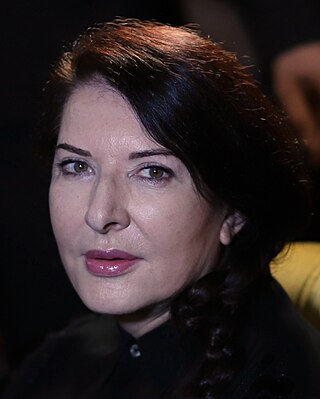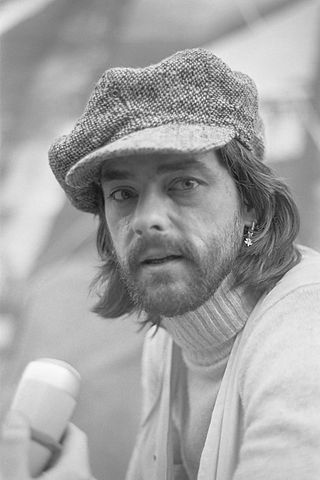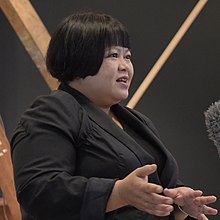
Performance art is an artwork or art exhibition created through actions executed by the artist or other participants. It may be witnessed live or through documentation, spontaneously developed or written, and is traditionally presented to a public in a fine art context in an interdisciplinary mode. Also known as artistic action, it has been developed through the years as a genre of its own in which art is presented live. It had an important and fundamental role in 20th century avant-garde art.

Marina Abramović is a Serbian conceptual and performance artist. Her work explores body art, endurance art, the relationship between the performer and audience, the limits of the body, and the possibilities of the mind. Being active for over four decades, Abramović refers to herself as the "grandmother of performance art". She pioneered a new notion of identity by bringing in the participation of observers, focusing on "confronting pain, blood, and physical limits of the body". In 2007, she founded the Marina Abramović Institute (MAI), a non-profit foundation for performance art.
Amanda Coogan is an Irish performance artist, living and working in Dublin. She studied under the performance artist Marina Abramović at the HBK Hochschule für Bildende Kunste, Braunschweig, Germany. In her performance art, she produces videos and photographs from live performances. Her work often begins with her own body and often challenges the expectations born of context.
LGBT art in Singapore, or queer art in Singapore, broadly refers to modern and contemporary visual art practices that draw on lesbian, gay, bisexual, and transgender+ imagery and themes, addressing topics such as LGBT rights, history and culture in Singapore. Such queer art practices are often by Singaporean or Singapore-based visual artists and curators who identify as LGBT+ or queer.

Frank Uwe Laysiepen, known professionally as Ulay, was a German artist based in Amsterdam and Ljubljana, who received international recognition for his Polaroid art and collaborative performance art with longtime companion Marina Abramović.
Chiharu Shiota is a Japanese performance and installation artist. Shiota has lived and worked in Berlin, Germany since 1996. Educated in Japan, Australia, and Germany, Shiota interweaves materiality and the psychic perception of the space to explore ideas around the body and flesh, personal narratives that engage with memory, territory, and alienation. Her signature installations, which consist of dazzling, intricate networks of threads stretching across gallery rooms, made the artist rise to fame in the 2000s. Shiota has exhibited worldwide. She made her debut in Japan at the Yokohama Triennale in 2001 with Memory of Skin and represented Japan in the 56th Venice Biennale in 2015.
Amanda Heng Liang Ngim is a contemporary artist, curator and speaker from Singapore, who works in Singapore and internationally. As an artist she has a multidisciplinary practice, working collaboratively in contemporary art exhibitions, performance, forums, workshops and art interventions. Her practice explores themes of national identity, collective memory and social relationships, gender politics and other social issues in urban, contemporary Singaporean society. She is the recipient of the 2019 Singapore Biennale's Benesse Prize.

Arahmaiani is an Indonesian artist born in Bandung and based in Yogyakarta, Central Java, Indonesia. Arahmaiani is considered by many to be one of the most respected and iconic contemporary artists, specifically in pioneering performance art in Southeast Asia. Arahmaiani frequently uses art as a means of critical commentary on social, religion, gender and cultural issues.
June Yap is a Singaporean curator, art critic, and writer. She is currently the Director of Curatorial & Collections at the Singapore Art Museum.
Mella Jaarsma is an artist originally from the Netherlands but now residing in Indonesia.
Latai Taumoepeau is an Australian contemporary artist. She is best known for her performance art, which explores the politics of race, colour and power in Australia. She has shown her works in leading Sydney galleries and venues including the Museum of Contemporary Art Australia, Carriageworks, Performance Space, the Sydney Opera House, Campbelltown Arts Centre, Casula Powerhouse Arts Centre, and the Australian Museum.
ShanghART Gallery is founded in 1996 by Swiss gallerist Lorenz Helbling as one of the first contemporary art galleries established in China. Initially operating out of a hotel, it has since expanded to four gallery spaces, two in Shanghai, and one each in Beijing and Singapore. For the past two decades, ShanghART has devoted to the development of contemporary art in China and kept close and long-term cooperation with more than 60 artists, building an audience for artists ranging from painters such as Yu Youhan and abstractionist Ding Yi, to artists midway through their career, Zhou Tiehai and Yang Fudong, as well as emerging artists like Zhang Ding and Chen Wei. The Singapore space in Gillman Barracks, established in 2013, extended their outreach to Southeast Asian artists such as Robert Zhao Renhui and Apichatpong Weerasethakul.

Juliana Yasin was a Singaporean contemporary artist and curator whose practice spanned painting, installation, video, and performance art. Her works examined notions of identity, subjectivity, and community practices. Pedagogy and research further complemented her artistic practice, with Juliana having taught fine art at Kolej Bandar Utama in Kuala Lumpur and worked as a Singapore-based researcher for the Asia Art Archive, Hong Kong.

Suzann Victor is a Singaporean contemporary artist based in Australia whose practice spans installation, painting, and performance art. Victor is most known for her public artworks and installations that examine ideas of disembodiment, the postcolonial, and the environmental in response to space, context and architecture.
Susie Lingham is a Singaporean contemporary artist, writer, curator, art theorist, and educator. Her practice often incorporates writing, sound, performance, and installation, synthesising interdisciplinary ideas related to the nature of the mind across different fields, from the humanities to the Sciences.
Siti Adiyati Subangun, better known as Siti Adiyati, is an Indonesian contemporary artist, educator, writer, and activist. Her work explores issues of social inequality, environmental degradation, and bureaucratic corruption.
Shubigi Rao is an Indian-born Singaporean contemporary artist and writer known for her long-term, multidisciplinary projects and installation works that often use books, etchings, drawings, video, and archives. Her interests include archaeology, libraries, neuroscience, histories and lies, literature and violence, and natural history. Rao has exhibited internationally, presenting work at the 59th Venice Biennale in 2022, 10th AsiaPacific Triennial in 2021, 10th Taipei Biennial in 2016, the 3rd Pune Biennale in 2017, the 2nd Singapore Biennale in 2008, as well as the 4th Kochi-Muziris Biennale in 2018.
Ho Tzu Nyen is a Singaporean contemporary artist and filmmaker whose works involve film, video, performance, and immersive multimedia installations. His work brings together fact and myth to mobilise different understandings of Southeast Asia's history, politics, and religion, often premised upon a complex set of references from art history, to theatre, cinema, and philosophy. Ho has shown internationally at major exhibitions such as the Aichi Triennale, Japan (2019), the Sharjah Biennial 14, United Arab Emirates (2019), and the Gwangju Biennale, South Korea (2018). In 2011, Ho represented Singapore at the 54th Venice Biennale at the Singapore Pavilion, presenting the work The Cloud of Unknowing.

Charwei Tsai is a Taiwanese multidisciplinary artist who lives and works in Taipei, Taiwan.
I Gusti Ayu Kadek (IGAK) Murniasih, also known as Murni, was a Balinese self-taught artist, and was one of the few Balinese women artists to have entered the mainstream Indonesian art scene. Her work is known for the depiction of disembodied bodies that transcend sexual violence, trauma and reclaim female sexuality.Murni's artworks have been exhibited and collected by galleries and museums including the National Gallery of Australia and the National Gallery of Singapore.











